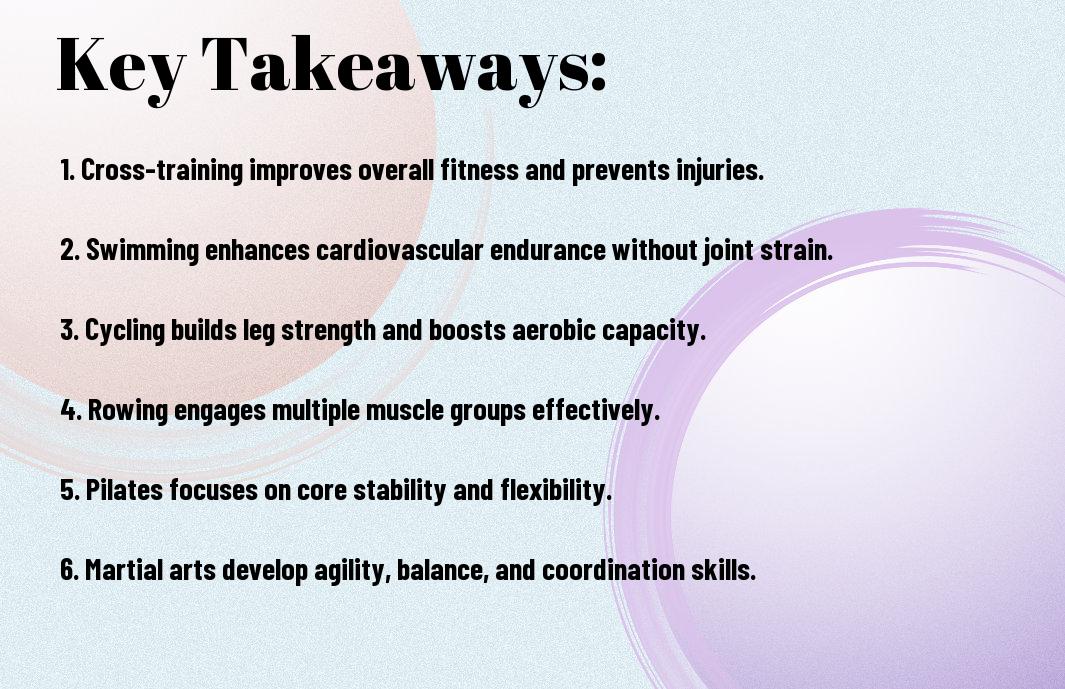Many athletes and fitness enthusiasts recognize the importance of cross-training in enhancing their performance and reducing the risk of injury. By diversifying your sporting activities, you not only improve different muscle groups but also build endurance, strength, and agility. In this post, you will discover some of the best sports for cross-training that can complement your primary athletic pursuits, offering variety and excitement to your routine. Whether you’re looking to boost your speed, increase your power, or enhance overall fitness, these sports will help you achieve your goals effectively.
Key Takeaways:
- Diverse Skill Development: Engaging in various sports enhances flexibility, strength, and endurance.
- Reduced Injury Risk: Cross-training helps to balance muscle groups, minimizing the risk of overuse injuries.
- Cardiovascular Benefits: Activities like cycling and swimming significantly improve heart health while being gentle on the joints.
- Enhanced Mental Motivation: Mixing up sports keeps the workouts fresh and engaging, preventing boredom.
- Improved Overall Performance: Cross-training supports performance in a primary sport by building complementary skills and fitness levels.
Benefits of Cross-Training
For athletes and fitness enthusiasts alike, cross-training offers a myriad of benefits that can enhance your overall athletic performance. By engaging in various activities outside your primary sport, you can build strength, increase endurance, and improve flexibility. This diverse approach not only keeps your workouts fresh and exciting but also optimizes your physical capabilities, allowing you to reach your fitness goals efficiently.
Improved Overall Fitness
Overall fitness is greatly enhanced through cross-training, as different exercises target various muscle groups and energy systems. Incorporating diverse activities helps you develop balanced strength, stamina, and agility, leading to a well-rounded physical condition. This holistic approach ensures that you don’t neglect vital aspects of your fitness while allowing you to perform better in your primary sport.
Injury Prevention
For those engaged in a specific sport, repetitive movements can lead to injuries, making cross-training an excellent method to mitigate risks. By varying your workouts, you can help condition muscles that are often overlooked and reduce stress on the same joints and connective tissues used in your primary activity.
A consistent cross-training regimen can significantly lower the likelihood of injuries by promoting muscle balance and flexibility. By mixing in different disciplines, such as swimming, cycling, or yoga, you allow your body to recover while still maintaining an active lifestyle. This not only aids in healing but also promotes a more resilient body, ultimately enabling you to continue pursuing your athletic ambitions with greater safety and effectiveness.

Top Sports for Cross-Training
If you want to elevate your fitness levels, consider incorporating cross-training into your routine. Some studies suggest that what type of cross training yields the biggest improvement … in overall performance can vary, but the right sports can significantly enhance your endurance, strength, and agility.
Swimming
Along with being a low-impact activity, swimming works out multiple muscle groups, making it an excellent form of cross-training. It enhances cardiovascular fitness while providing your joints a break from high-impact exercises.
Cycling
Any athlete seeking to boost their stamina and leg strength should consider cycling. It’s exceptionally effective for enhancing cardiovascular endurance while allowing for low-impact, weight-bearing activity.
Hence, cycling can be easily adjusted to your fitness level. Whether you choose to ride on a stationary bike or hit the trails, this sport improves leg strength and stamina while being gentle on your joints.
Rowing
One of the most comprehensive workouts, rowing engages your entire body, targeting your legs, core, and arms. It builds muscular strength while also providing a solid aerobic workout.
Further, rowing can be done on water or using a rowing machine, making it versatile for any fitness level. It’s an effective way to enhance your endurance and strength simultaneously, perfect for athletes looking to diversify their training.
Martial Arts
Around the world, martial arts has gained popularity for its unique blend of fitness and self-defense training. It improves flexibility, balance, and coordination while also providing a full-body workout.
Rowing, as you engage in martial arts, teaches discipline and mental focus while promoting physical strength. Various forms, such as Karate or Brazilian Jiu-Jitsu, offer different benefits, helping you become well-rounded in your cross-training efforts.
Yoga
Arts-based workouts like yoga enhance flexibility and mental clarity, vital for any athlete. Incorporating yoga into your routine can improve your strength, balance, and endurance.
This practice not only helps in stretching out tight muscles but also aids in recovery. By enhancing your mindfulness, yoga allows you to reconnect with your body, making it a valuable addition to your cross-training regimen.
How to Integrate Cross-Training into Your Routine
Now that you understand the benefits of cross-training, integrating it into your routine can optimize your performance and prevent burnout. Start by gradually adding different activities to your weekly plan, making sure to balance your primary sport with complementary exercises. Aim for two to three cross-training sessions per week, allowing your body to adapt while keeping your routine fresh and engaging.
Creating a Balanced Schedule
Around your main sport, you should design a schedule that incorporates a variety of training modalities. Consider allocating specific days for cross-training activities, ensuring you maintain a blend of endurance, strength, and flexibility workouts. This holistic approach will not only enhance your skills but also aid in recovery by using different muscle groups.
Listening to Your Body
About integrating cross-training successfully requires awareness of how your body feels during and after workouts. Pay attention to any signs of fatigue, soreness, or discomfort, and adjust your schedule accordingly. Balancing intensity levels and allowing for rest days will help you avoid overtraining and keep your motivation high.
Considering the signals your body sends is crucial for safe and effective cross-training. If you find yourself consistently fatigued or experiencing persistent pain, take a step back and reassess your routine. Prioritizing recovery, adjusting the intensity of workouts, and giving yourself adequate rest will ensure that you continue progressing without risking injury. By tuning in to your body’s needs, you can establish a sustainable practice that promotes long-term athletic success.
Sport-Specific Cross-Training Advantages
Keep in mind that incorporating sport-specific cross-training can significantly enhance your performance in your primary sport. By engaging in activities that mimic the movements and demands of your main sport, you can improve your overall skills and reduce the risk of injury. This targeted approach allows you to develop complementary skills that not only boost your performance but also keep your training regime fresh and exciting.
Enhancing Endurance
Cross-training with endurance-focused activities, such as running or cycling, allows you to build a solid aerobic base. These exercises elevate your heart rate, increase lung capacity, and improve overall stamina, which can translate into improved performance in your primary sport.
Building Strength and Agility
One of the primary benefits of sport-specific cross-training is the opportunity to build strength and agility. Engaging in complementary activities challenges your muscles in new ways and enhances your physical capabilities.
To maximize your efforts in building strength and agility, choose exercises that support the movements of your sport. For instance, if you play basketball, incorporating plyometric drills can improve your vertical leap. Similarly, swimmers might benefit from resistance training that targets upper body strength. By aligning your cross-training with your sport’s specific demands, you can accelerate your performance gains while enjoying a well-rounded fitness journey.
Tips for Choosing the Right Cross-Training Activities
Unlike selecting a single sport, choosing cross-training activities requires a thoughtful approach. Consider factors such as:
- Your current fitness level
- Your personal preferences
- The time you can commit
- Your injury history
Knowing your unique needs will help you pick activities that enhance your performance and enjoyment.
Assessing Personal Goals
Between improving endurance, building strength, or increasing flexibility, your specific objectives should guide your choice of cross-training. Align your activities with the outcomes you want to achieve, ensuring a more effective training regimen.
Exploring Local Options
For finding suitable cross-training activities, look into local gyms, community centers, or sports clubs that offer diverse classes and programs. Engaging with others can enhance your experience while introducing you to new sports.
Cross-training doesn’t have to be a solitary pursuit; join local clubs or groups to discover activities that spark your interest. Many communities offer fitness classes, swimming pools, or outdoor sports groups, providing you with numerous options. Engaging with fellow enthusiasts can also motivate you and help you discover new forms of exercise that complement your primary training focus.

Common Misconceptions About Cross-Training
All too often, individuals dismiss cross-training as an unnecessary component of athletic training. Some believe it is only beneficial to elite athletes or those pursuing professional sports. However, cross-training can enhance performance and prevent injuries for recreational athletes as well, making it an invaluable addition to your routine, regardless of your fitness level.
Only for Elite Athletes
Misconceptions about cross-training often lead people to believe that only elite athletes can benefit from it. In reality, individuals of all skill levels can enhance their physical abilities, prevent injury, and improve overall fitness through a well-rounded cross-training regimen.
Time-Consuming
The idea that cross-training is time-consuming can deter many from incorporating it into their routines. However, you can efficiently include complementary workouts into your existing schedule without dedicating excessive time. Short, focused sessions can yield significant benefits.
Indeed, you don’t need to allocate hours each week specifically for cross-training. With strategic planning, you can incorporate it seamlessly into your schedule. Many cross-training exercises are quick and can be done in as little as 20-30 minutes. This means you can reap the benefits without it feeling like a burden, making your overall training regimen more flexible and enjoyable.
To wrap up
Hence, incorporating a variety of sports into your cross-training regimen can significantly enhance your overall performance and fitness levels. By engaging in activities such as swimming, cycling, or martial arts, you can build different muscle groups, improve endurance, and prevent injury. Balancing these sports allows you to develop a well-rounded fitness foundation while keeping your routine fresh and enjoyable. Ultimately, choosing the right sports for cross-training tailored to your goals will elevate your training experience and outcomes.
FAQ
Q: What is cross-training, and why is it important for athletes?
A: Cross-training refers to engaging in different types of exercise or sports to improve overall performance and fitness. It is important for athletes because it helps prevent burnout from repetitive training, reduces the risk of injuries by balancing muscle groups, and enhances overall athletic performance by developing different skills. For instance, a runner might incorporate cycling or swimming to build endurance while also minimizing impact on their joints.
Q: What are some of the best sports for cross-training and their benefits?
A: Several sports are highly effective for cross-training, including swimming, cycling, and rowing. Swimming is low-impact and great for building cardiovascular endurance while strengthening upper body muscles. Cycling provides an excellent aerobic workout that strengthens the legs and improves core stability. Rowing combines both aerobic and strength training, effectively working the back, arms, and legs while promoting cardiovascular fitness. Incorporating these activities into a regular training regimen can lead to improved performance and reduced injury risk.
Q: How often should I include cross-training in my workout regimen?
A: The frequency of cross-training sessions depends on individual fitness goals, but many athletes find that integrating cross-training 1 to 3 times per week works well. This approach allows for recovery days tailored to specific activities while still maintaining a focus on primary sports. For example, a long-distance runner may choose to swim or bike on alternating days to help build endurance and enhance recovery without stressing the same muscle groups involved in running.


